US Dollar Exchange Rates of
10th
Dec
2023
China Yuan 7.16
Report from China
Log imports from New Zealand remained firm
According to China Customs, in the first 10 months of this
year log imports from New Zealand were 14.51 million
cubic metres, up slightly (1.1%) accounting for 46% of the
national total and valued at US$1.796 billion, down 20%.
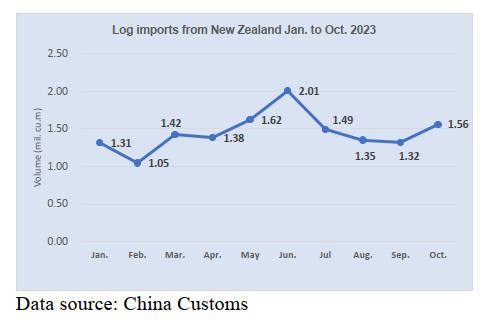
The volume of New Zealand's log exports to China did not
show significant growth up to October this year. In the
first 10 months of 2023 imports increased by about 2%
percentage points year on year and in the third quarter of
2023 imports fell by 17% quarter-on-quarter and 11%
year-on-year.
After a three-month decline in imports between July and
September 2023 China’s log imports from New Zealand
rose 18% to 1.57 million cubic metres in October, up 3
percentage points year-on-year. The average CIF price for
log imports from New Zealand in October fell 21% to
US$124 per cubic metre over the same period in 2022.
The CIF price for log imports from New Zealand
fluctuated between January and October in 2023.
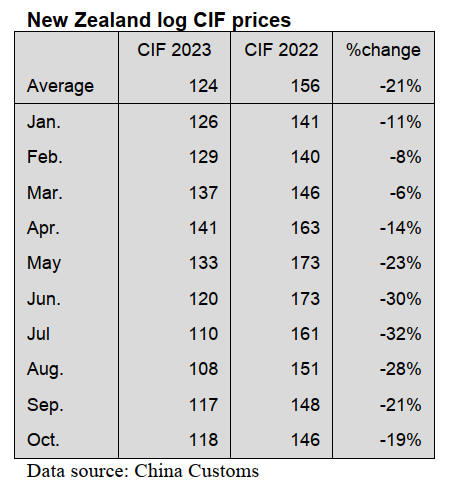
It has been reported that prices for New Zealand logs are
showing signs of recovery. Prices in November 2023 were
US$9 per cubic metre higher than in October 2023 and
prices for logs from North Island exporters in New
Zealand rose US$5-10 per cubic metre.
It has become apparent that New Zealand forestry
companies are seeking new markets, however, China
accounts for more than 80% of New Zealand log exports.
In addition to the Chinese market, New Zealand is also
exporting logs to South Korea and India is being
considered as a new target market. The Indian market has
become more attractive as prices paid by Indian importers
are now close to those paid in China. New Zealand timber
traders have suggested prices in the Korean market are
trending below those for the Chinese market at present.
Behind the decline in New Zealand log prices is weak
domestic demand and a slowdown in international
demand. It is anticipated that China's future imports of
New Zealand logs will be maintained at current levels.
National forest reserve project for Guangxi
According to the State-owned Assets Supervision and
Administration Commission of the State Council a
RMB10 billion national forest reserve project strategic
framework agreement was recently signed between China
Energy Engineering Group Guangxi Electric Power
Design Institute Co., Ltd. and the People’s government in
Baise City of Guangxi Zhuang Autonomous Region.
The agreement says the two sides will cooperate to
establish a national reserve forest of nearly 67,000
hectares in six counties (districts) including Youjiang
District, Debao County and Tianlin County. The focus will
be on the development of mainly commercial species such
as eucalyptus, pine, Chinese cedar as well as oil-tea
camellia and star anise.
The new forest reserve will improve forest quality,
enhance forest carbon sequestration and promote green
industry development and rural revitalisation and help to
achieve the goal of "carbon peak, carbon neutrality".
Guangxi has been ranked first in timber production in
China for 16 consecutive years and is the largest and most
important wood production base in the country. The
signing of this agreement is an example illustrating that
China can establish forest projects to promote the
sustainable development of the industry and address
climate change.
See:
https://www.forestry.gov.cn/c/stzx/zxzx/535921.jhtml
Plywood exports to the Middle East and Africa
increase
According to China Customs in the first 8 months of 2023
plywood exports were 6.983 million cubic metres valued
at US$3.193 billion, a year-on-year decrease of 4% in
volume and 19% in value. China’s plywood exports to the
Philippines and UK, as the first and second destinations,
fell 11% and 8% respectively in the first 8 months of
2023.
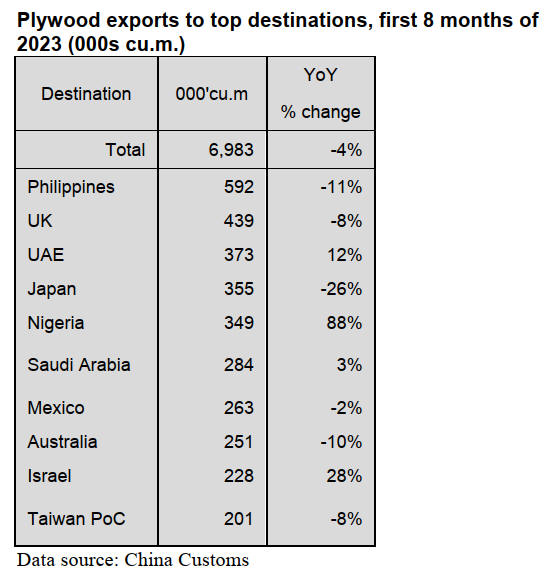
China’s plywood exports to the Middle East and Africa
increased. China’s plywood exports to Nigeria surged 88%
from the same period of 2022. China’s plywood exports to
UAE, Saudi Arabia and Israel rose 12%, 3% and 28%
respectively in the first 8 months of 2023.
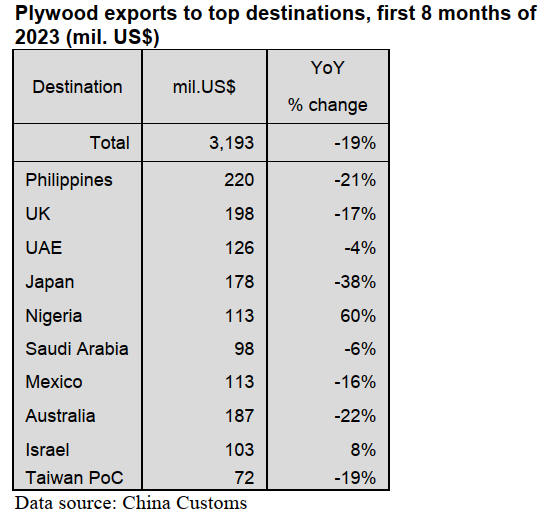
Surge in tropical plywood exports to the Philippines
According to China Customs, tropical plywood exports
amounted to 383,000 cubic metres valued at US$161
million in the first 8 months of 2023, a year on year
decrease of 5% in volume and 17% in value from the same
period of 2022.
Tropical plywood exports to the Philippines, as the largest
destination country, surged 64% year on year to 78,000
cubic metres. At the same time, China’s tropical plywood
exports to Mexico and South Korea also rose 47% and
34% respectively. China’s tropical plywood exports to
other destination countries and regions fell at different
rates in the first 8 months of 2023.

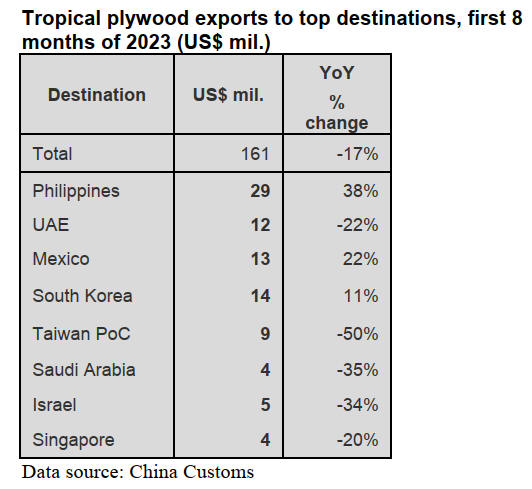
As the second largest market for China’s plywood exports
the UK did not import any significant volumes of tropical
plywood in the first 8 months of 2023.
Decline in both wood furniture exports and imports
According to China Customs, wooden furniture exports
and imports fell in the first 10 months of 2023. China’s
wooden furniture exports in the first 10 months of 2023
were worth US$19.35 billion, a year-on-year decline 9%.
The US remained the largest market for China’s wooden
furniture exports in the first 10 months of 2023 but the
value of exports to the US were US$5.64 billion, down 5%
year on year, accounting for 29% of the national total.
China exported wooden furniture to more than 200
countries in the first 10 months of 2023 and the value of
wooden furniture exports to the top 5 markets accounted
for just 53% of the national total.
China’s wooden furniture exports to UK, alone, rose
among the top destination countries. However, China’s
wooden furniture exports to the US, Australia, Japan and
South Korea fell 5%, 16%, 13% and 5% respectively in
the first 10 months of 2023 resulting in the overall decline
in wooden furniture exports.
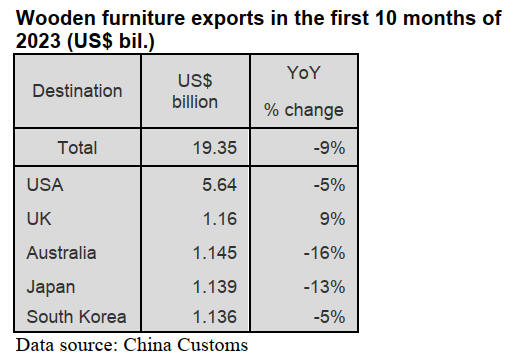
China’s wood furniture exports to Italy just amounted to
US$132 million but rose 22% in the first 10 months of
2023.
Wooden furniture imports
China’s wooden furniture imports amounted to US$637
million,in the first 10 months of 2023, a year-on-year
decline 15%. Italy was the largest supplier of wooden
furniture imports in the first 10 months of 2023 and they
were worth US$286 million, down 16% year on year and
accounting for 45% of the national total.
China imported wooden furniture from more than 80
suppliers worldwide and the value of China’s wooden
furniture imports from the top 8 suppliers accounted for
83% of the national total.
China’s wooden furniture imports from Sweden, alone,
rose among the top suppliers. However, China’s wooden
furniture imports from the other top suppliers fell at
different rates in the first 10 months of 2023 resulting in
the decrease of the national total wood furniture imports.
China’s wood furniture imports from USA in the first 10
months of 2023 amounted to US$3.76 million, a year-
on-year decrease of 40%.

Global Legal and Sustainable Timber Forum 2023
On 21 and 22 November the Global Legal and Sustainable
Timber Forum (GLSTF) 2023 was held in Macao SAR,
China with the theme "Connect, Cooperate and Share to
Promote the Recovery of the Global Tropical Timber
Market". The Forum brought together more than 700
representatives from enterprises, business associations,
international organisations, governments and NGOs from
36 countries and regions.
The results of a number of international projects were
presented at the Forum including the “Establishment and
Operation of the Global Timber Index (GTI) Platform”
and the “Research on the Collaborative Operations of the
Blockchain-based Timber Traceability System (BTTS)”.
During the two-day event, representatives from industry in
several countries signed a “Joint Declaration of Intent for
Sustainable Forest Management and Responsible Timber
Industry Operations” and a cooperation agreement for
Green Finance for Green Supply Chains (GF4GS) Action.
Participants at the Forum said “this is a very difficult and
challenging time for the global timber industry. Perhaps
for the first time all the major markets of the world are
slowing at the same time, weighed down by the economic
volatility that followed on from the COVID pandemic,
armed conflicts, trade disputes, rising energy prices,
climate change and mounting pressure on resources”.
Participants emphasised the need to develop a strong
international network to build cooperation and share
knowledge and experience in sustainable timber
production and supply, adding that “the Global Timber
Index (GTI) provides a valuable platform to improve the
quality and regularity of timber market information, to
encourage greater information exchange within the private
sector, and thereby enhance the accuracy of policy
formulation in relation to legal and sustainable trade”.
GTI report - November
In November this year the construction sector in China
showed a noticeable upward trend and the overall
performance of Chinese timber enterprises was stable.
The entreprises contributing to the GTI-China reported
that their production volume and domestic orders
increased compared with the previous month, purchases of
raw materials were more active however, the number of
international orders continued to decline due to the
sluggish global timber market.
This month, the GTI-China index recorded 54.0%, a
decrease of 1.2 percentage points compared to that of the
previous month but was above the critical value (50%)
where it has been for two consecutive months indicating
that the business prosperity of the timber enterprises
represented by the GTI-China index expanded.
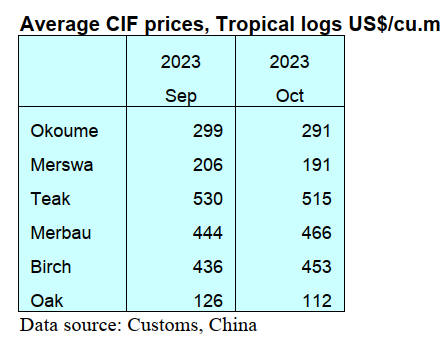 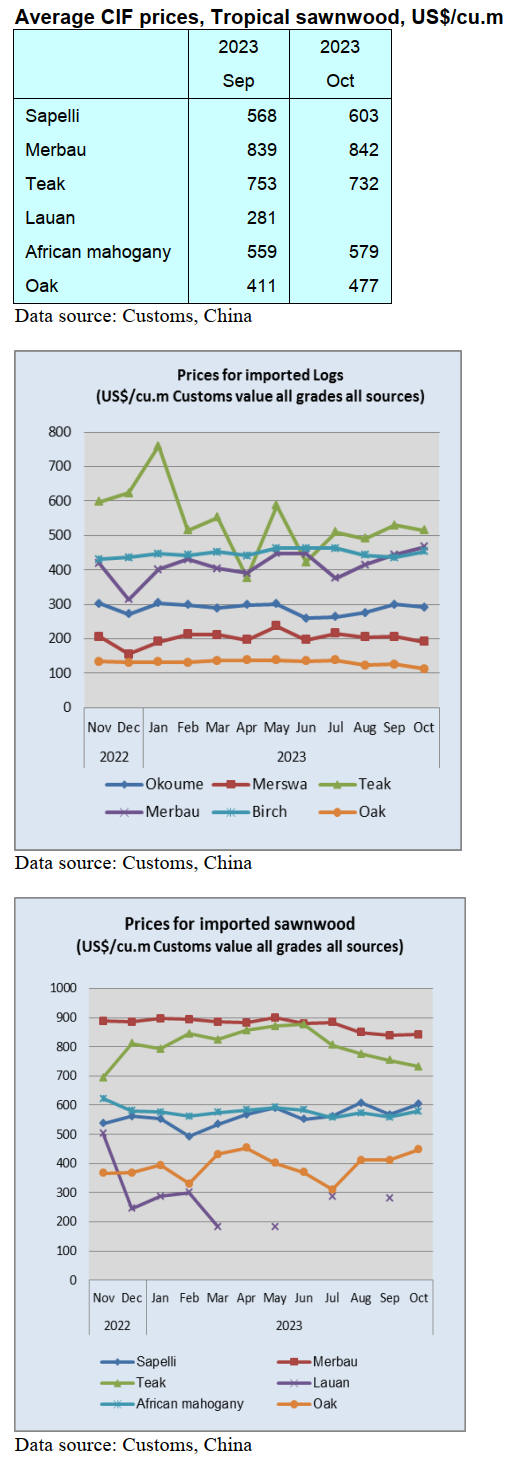
Through the eyes of industry
The latest GTI report lists the challenges identified by the private
sector in China
See:
https://www.itto-ggsc.org/static/upload/file/20231121/1700552181514582.pdf
|